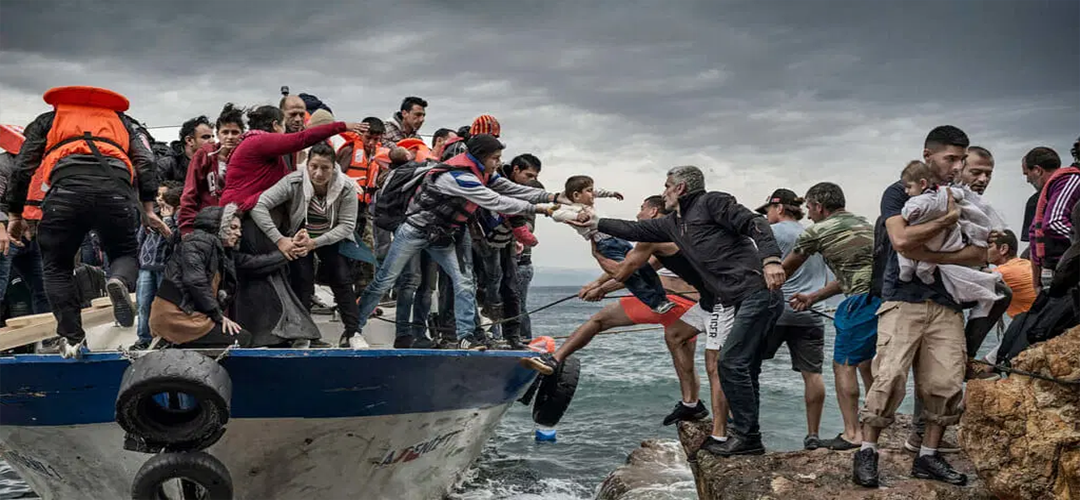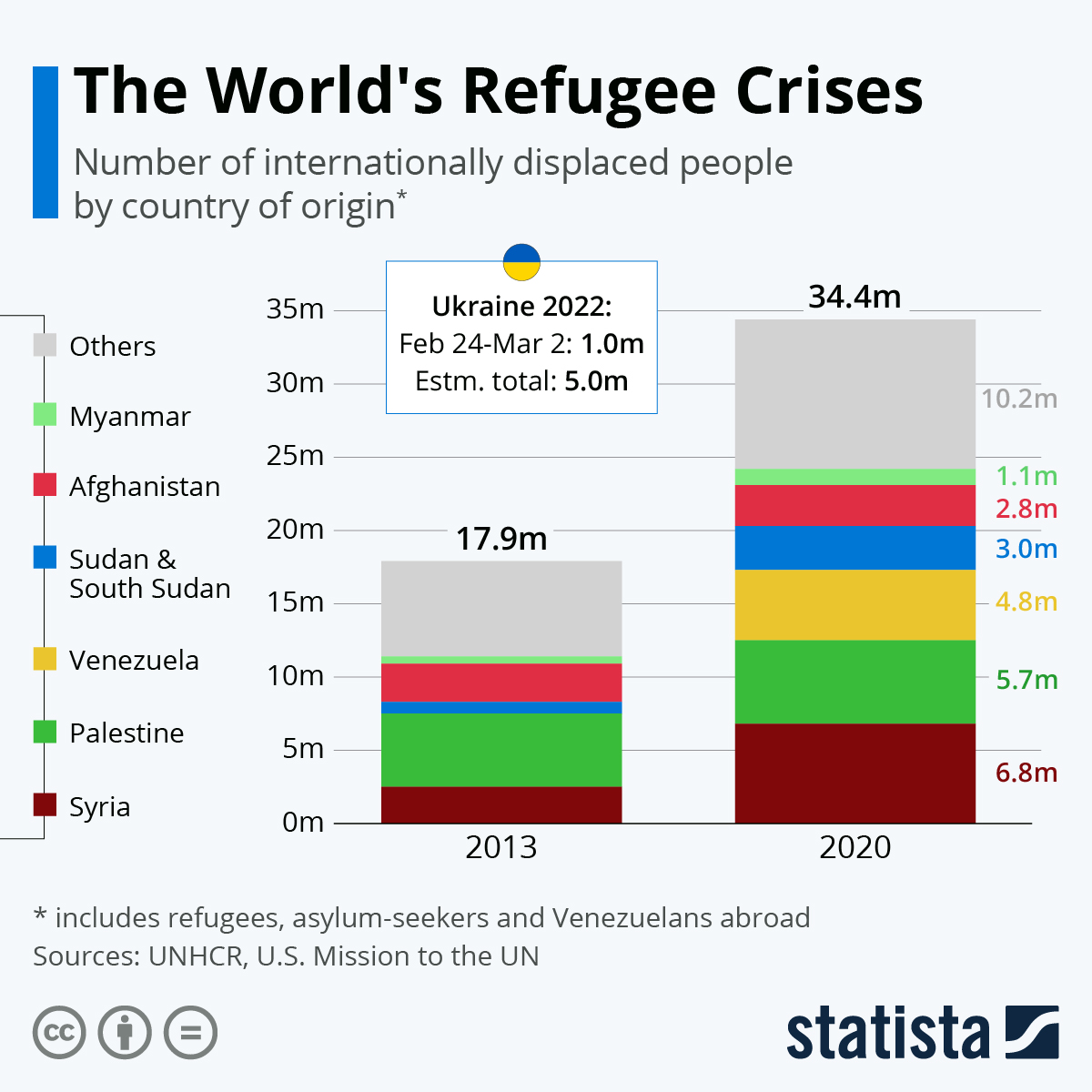2022-the Year of Displaced People?
January 28, 2023 | Expert Insights

Hidden from public view, something that rarely figures in our media is the plight of millions of traumatized citizens across the globe who live not to thrive but merely to survive from day to day, somehow eking out a life of bare sustenance. For millions, their homeland cannot meet their basic necessities, displacing them within their country or, worse, across porous borders and oceans.
While refugees due to conflicts, famine and poverty have been a constant reminder of mankind's malaises, their numbers have only increased over the years, reaching a record 100 million in 2022, as per UNHCR figures.
Background
In response to mass persecution and displacements during the Second World War, the United Nation's 1951 convention drafted a modern definition of Refugees. According to the Convention, a refugee is unable or unwilling to return to their country of origin owing to a well-founded fear of being persecuted for race, religion, nationality, or membership of a particular social group, or political opinion.
Over the decades, the increase in the global refugee population has been majorly attributed to the conflict-riven territories of the Syrian Arab Republic, Myanmar, Afghanistan and the Central African Republic. Though 2022 marked a sharp rise in the refugee population, it also follows the same trend, which means that many refugees still come from the same countries, with the only major addition being Ukraine.

Analysis
It is hardly surprising that the Middle East and North Africa, one of the most volatile regions in the world, account for the largest percentage of displaced persons. Since the civil war in Syria in 2011, the country has contributed the leading number of refugees to global figures. As it completes over a decade of fighting, the Syrian war continues to displace its citizens at the same alarming rate. The Western empathy for the war-affected civilians of Syria could perhaps be a ray of hope for the displaced in these unfortunate countries as they continue to cross the Mediterranean in record numbers, with an unrecorded number losing their lives in the process. The fact that ISIS jumped into the fray in Syria attracted the attention of the West in its global war on terror, turning the civil war into a proxy conflict between external actors, which included the Western powers, Russia, Iran and her proxies and neighbouring countries like Turkey. A 2022 Report compiled by the Independent International Commission of Inquiry on the Syrian Arab Republic places the numbers dying due to displacements in millions. The Assad regime contributes to this exodus as returnees from refugee camps face detention and arrest by government security agencies, thus limiting the number of displaced persons willing to return home. As a result, the spillover from Syrian refugee camps is flooding over the borders into neighbouring countries like Iraq, Jordan, and Lebanon, adding to these countries' already delicate economic and humanitarian situation.
Another region of concern is the East and Horn of Africa and the Great Lakes region. The region includes the states of Congo, Somalia, Uganda, Eritrea, Sudan, etc. Here, the movement of people has only intensified for reasons of civil war, violence between different ethnic groups, climate change-induced concerns, political volatility, human rights violation, food insecurity, Covid-19 and other socioeconomic issues.
Southern Africa and West and Central Africa have been severely impacted by the COVID-19 pandemic and suffering from inadequate health and social services and fragile economies; they, too, are witnessing their citizens moving in droves seeking survival and sustenance elsewhere. Relatively prosperous South Africa, Nigeria and other better-off nations in the region are swamped by a flood of economic migrants, which in turn triggers violent xenophobic reactions in their countries. As per the UNHCR, Southern Africa will see the greatest influx of refugees in the near future.
Who could have imagined in their wildest dreams that prosperous, all-white Europe would see a record refugee movement reminiscent of the Nazi blitzkrieg of 1939? In 2022, Ukraine had the dubious distinction of being the second largest country of origin for the global refugee population, with nearly 8 million refugees spreading across Europe as far as the British Isles.
In comparison, the Asia Pacific region was an island of tranquillity, with only Afghanistan and Myanmar producing a displacement of citizens due to humanitarian reasons in the case of Afghanistan and because of brutal military oppression in Myanmar. The Rohingyas remain an unresolved blot on humanity, drifting from one country to another while facing ongoing persecution in their native Myanmar. At the end of 2022, it was estimated that nearly one million Rohingyas are taking shelter in Bangladesh alone under conditions that are hardly humane. Afghanistan is an old story, and it was hoped that with the West moving out of the country after its two-decade-long experiment with democracy, things would settle down in this forsaken nation. However, with Taliban 2.0 turning out to be no different from the original version that American firepower had evicted from Kabul 20 years ago, the quality of life of the common Afghani rapidly deteriorated from sustenance level to abject poverty and starvation. This has resulted in a dismal humanitarian situation and human rights violations, and hence, people are continuously fleeing from Afghanistan.
Another area of concern is Latin America which, although resources rich, has been in political turmoil for a very long time. A once prosperous and oil-rich nation like Venezuela is now an international pariah, with its population facing the largest external displacement crisis. The worst part of the crisis is that it defies the conventional understanding of a refugee because people fleeing from Venezuela are economic refugees searching for better living standards. Thus, they are not included in the traditional definition of refugees, which focuses on causes of war and persecution. As of 2022, there are more than 7 million refugees from Venezuela worldwide. Other American countries like El Salvador and Guatemala have also seen displacement due to reasons of violence and catastrophic climatic events. Several states in the American Continent have other factors for the refugee crisis, such as political volatility, and the common factor among all is the impact of Covid-19.
Being a refugee is not the best situation any family could find itself in. Of course, if you are fortunate enough to find refuge in one of the better-run UN refugee camps, then perhaps your immediate survival is more or less assured. However, your future remains as tenuous as ever.
The most common consequence is hardships for refugees as they are left with no choice but to remain in camps for years because resettlement and long-term integration options are often limited. Escalating violence also makes it difficult for humanitarian organizations to work in the country.
But there are positive examples also, and one of them is Finland. The country uses smart contracts backed by blockchain technology. Since refugees have to start from the beginning, given their lost legal identities, these smart self-executing contract helps them to open a bank account, avail of government services and even to get employment. This is done by giving them a smart prepaid master card containing a digital identity number which maintains records of all the financial transactions done with the card. It is designed so that the system is traceable, transparent and irreversible. However, a generous and considerate nation like Finland can shelter only a few refugees.
Assessment
- The rich Western nations have tried to styme the flow of refugees into the European heartland through a mix of preventive measures (tough border control measures) and trying to economically revive the homelands from where the bulk of migration to European shores is taking place. But there is little progress on the ground, as the rising number of refugees indicates. Hence, richer nations will have to continue to accept refugees within their borders on the grounds of humanity.
- In the medium term, the impact on growth and development depends on how the refugees are integrated into the host country. Various factors which play a role here include the age of the refugees, availability of resources in the country, opportunities given to the refugees, the extent of their participation in the labour market, and formulation and implementation of policies for the refugees. Of course, the Finnish model provides the best template.
- The number of global refugees will only grow as calamitous natural events triggered by climate change are afflicting millions with drought, famine, floods, rising sea levels and earthquakes. The global North must accept and implement the principle of “Common but differentiated responsibility” sooner than later if it wishes to retain its exclusive level of prosperity and not be marred by millions of hungry, desperate refugees knocking at its doors.








Comments